The Arkansas darter is a species of freshwater ray-finned fish, a darter from the subfamily Etheostomatinae, part of the family Percidae, which also contains the perches, ruffes and pikeperches. It is endemic to the United States where it is found in Kansas, Arkansas, Missouri, Colorado, and Oklahoma.
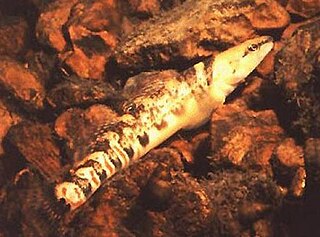
The Niangua Darter is a species of freshwater ray-finned fish, a darter from the subfamily Etheostomatinae, part of the family Percidae, which also contains the perches, ruffes and pikeperches. It is endemic to Missouri, United States. It is found only in the Osage River Basin of central Missouri where its range historically included the Sac River, Pomme de Terre River, Niangua River, Big Tavern Creek, and Maries River. It is a federally listed threatened species of the United States.
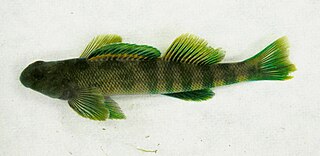
The greenside darter is a species of freshwater ray-finned fish, a darter from the subfamily Etheostomatinae, part of the family Percidae, which also contains the perches, ruffes and pikeperches. It inhabits swift riffles in the eastern United States and southern Ontario.

The mud darter is a species of freshwater ray-finned fish, a darter from the subfamily Etheostomatinae, part of the family Percidae, which also contains the perches, ruffes and pikeperches. It is endemic to the lowlands of the Mississippi River basin from Wisconsin and Minnesota south to Louisiana and East Texas. It is also found in the drainages of the Sabine and Neches Rivers of Texas and Louisiana. It can be found in slow-moving waters on riffles in rivers, as well as in creeks, swamps, lakes, and reservoirs. It mostly consumes the larvae of midges and blackflies. This species can reach a length of 7.1 cm (2.8 in), though most only reach a length of 5 cm (2.0 in).
The golden darter is a species of freshwater ray-finned fish, a darter from the subfamily Etheostomatinae, part of the family Percidae, which also contains the perches, ruffes and pikeperches. It is found in the upper Tennessee River, one of the over 300 fish species found in Tennessee.

The swamp darter is a species of freshwater ray-finned fish, a darter from the subfamily Etheostomatinae, part of the family Percidae, which also contains the perches, ruffes and pikeperches. It is endemic to the Eastern United States.
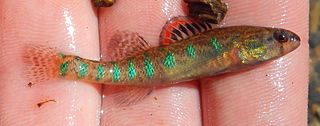
Etheostoma gracile, the slough darter, is a small species of ray-finned fish, a darter from the subfamily Etheostomatinae, part of the family Percidae which includes the perches, ruffs and pike-perches. It inhabits slow to moderately flowing waters and with substrates that are predominantly mud, silt, or sand. Major food sources include chironomids, copepods, and cladocerans, as well as mayflies in the spring. Adults reach 35 to 50 mm total length. It is one of the 324 species of fish found in Tennessee.
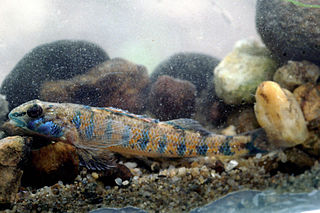
The speckled darter is a species of freshwater ray-finned fish, a darter from the subfamily Etheostomatinae, part of the family Percidae, which also contains the perches, ruffes and pikeperches. It is endemic to the central and southeastern United States. It occurs in the Mississippi River basin and through the Gulf Coast drainages. It is also found in the Clinch River and the Powell River. This species inhabits rocky or sandy pools in flowing waters up to the size of medium rivers with fast currents. It can reach a length of 6.1 centimetres (2.4 in) TL though most only reach about 4 centimetres (1.6 in).
The Cumberland darter is a rare species of freshwater ray-finned fish, a darter from the subfamily Etheostomatinae, part of the family Percidae, which also contains the perches, ruffes and pikeperches. It is endemic to Kentucky and Tennessee in the United States, where it occurs in the upper Cumberland River tributaries above Cumberland Falls. It was federally listed as an endangered species in the US on August 9, 2011.

Etheostoma etowahae, the Etowah darter, is a species of freshwater ray-finned fish, a darter from the subfamily Etheostomatinae, part of the family Percidae, which also contains the perches, ruffes and pikeperches. It is a rare species which is endemic to Georgia in the United States, where it occurs only in the Etowah River and two of its tributaries. It is a federally listed endangered species of the United States.

The redfin darter is a species of freshwater ray-finned fish, a darter from the subfamily Etheostomatinae, part of the family Percidae, which also contains the perches, ruffes and pikeperches. It is native to the south-central United States, where it occurs in Missouri, Arkansas, Kansas, and eastern Oklahoma.
The glassy darter is a species of freshwater ray-finned fish, a darter from the subfamily Etheostomatinae, part of the family Percidae, which also contains the perches, ruffes and pikeperches. It is found from the Bush River in Maryland to Neuse River in North Carolina. It inhabits sandy runs of creeks and small to medium rivers. This species can reach a length of 6.6 cm (2.6 in), though most only reach about 4.7 cm (1.9 in).
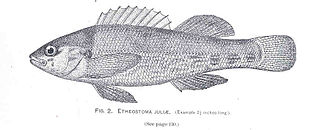
The yoke darter is a species of freshwater ray-finned fish, a darter from the subfamily Etheostomatinae, part of the family Percidae, which also contains the perches, ruffes and pikeperches. It is endemic to the eastern United States, where it occurs in the White River drainage in southern Missouri and northern Arkansas. It inhabits clear, fast, rocky riffles of creeks and small to medium rivers. This species can reach a length of 7.8 cm (3.1 in). The specific name honors Mrs Julia Hughes Gilbert, the wife of the American ichthyologist Charles Henry Gilbert (1859-1928).
The Missouri saddled darter is a species of freshwater ray-finned fish, a darter from the subfamily Etheostomatinae, part of the family Percidae, which also contains the perches, ruffes and pikeperches. It is endemic to Missouri, where it occurs in the Ozarks from the Gasconade River to the Osage and Moreau rivers. It occurs in fast gravel and rubble riffles of small to medium rivers. This species can reach a length of 9.0 cm (3.5 in).
The Arkansas saddled darter is a species of freshwater ray-finned fish, a darter from the subfamily Etheostomatinae, part of the family Percidae, which also contains the perches, ruffes and pikeperches. It is endemic to the eastern United States, where it occurs in the White River drainage in Arkansas and Missouri. It occurs in deep, fast gravel and rubble riffles of small to medium rivers. This species can reach a length of 12.0 cm (4.7 in).
The current darter is a species of freshwater ray-finned fish, a darter from the subfamily Etheostomatinae, part of the family Percidae, which also contains the perches, ruffes and pikeperches. It is endemic to the eastern United States. This fish occurs in the Black River drainage system from south central Missouri to north central Arkansas, where it is found in shallow gravel riffles, sometimes rocky runs and pools of headwaters and creeks.
The brook darter is a small species of freshwater ray-finned fish, a darter from the subfamily Etheostomatinae, part of the family Percidae, which also contains the perches, ruffes and pikeperches. It is endemic to the eastern United States, where it occurs in the upper Black River system in Missouri, from headwaters to where the River flows into the Mississippi River alluvial plain. It inhabits shallow gravel riffles, sometimes rocky runs and pools, of headwaters, creeks, and small rivers. The brook darter was first formally described in 1997 by Patrick A. Ceas and Lawrence M. Page with the type locality given as the Black River on the northeastern outskirts of Mill Spring, Missouri. The specific name honours Brooks M. Burr, Emeritus Professor and Curator of Fishes of Southern Illinois University who first brought the fish to the attention of the authors.
The Autumn darter is a species of freshwater ray-finned fish, a darter from the subfamily Etheostomatinae, part of the family Percidae, which also contains the perches, ruffes and pikeperches. It is endemic to the eastern United States, where it commonly occurs in the White River drainage and tributaries, and less so in the upper Current and Eleven Point Rivers, of Missouri and Arkansas, and the Little Red River in Arkansas.
The Meramec saddled darter is a species of freshwater ray-finned fish, a darter from the subfamily Etheostomatinae, part of the family Percidae, which also contains the perches, ruffes and pikeperches. It is endemic to the eastern United States, where it occurs in the larger streams of the Meramec River drainage of Missouri. It inhabits fast gravel and rubble riffles of small to medium rivers. This species can reach a length of 7.1 cm (2.8 in).
The sunburst darter is a species of freshwater ray-finned fish, a darter from the subfamily Etheostomatinae, part of the family Percidae, which also contains the perches, ruffes and pikeperches. It is found in the Arkansas River drainage in southeastern Kansas, southwestern Missouri, northeastern Oklahoma, and northwestern Arkansas. It inhabits small, clear, cool streams and creeks with a clean gravel and/or cobble substrate.









